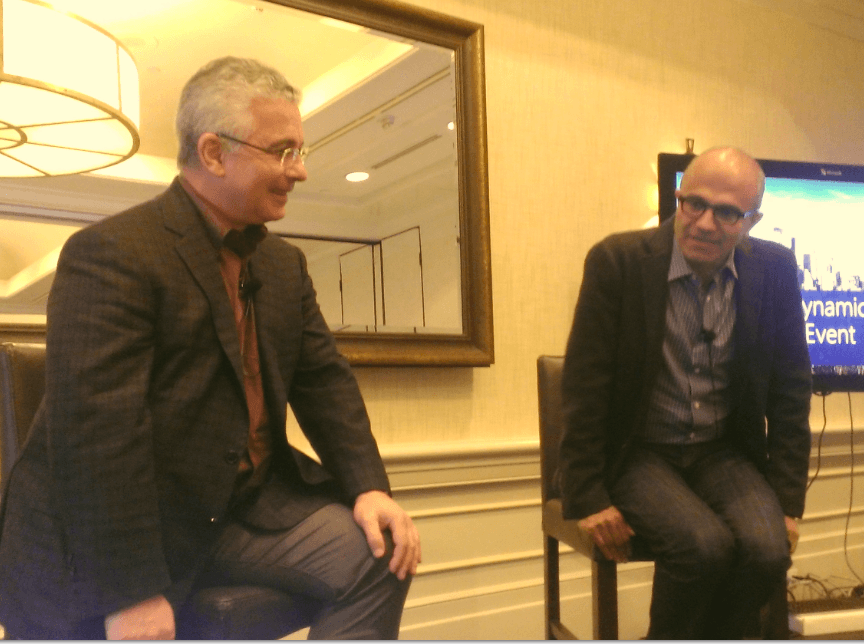
In a letter to Microsoft employees today, CEO Satya Nadella announced a major restructuring of its business. From the hometown paper, the Seattle Times:
The reorganization announced Wednesday, which builds on a 2013 restructuring under Ballmer, will consolidate Microsoft’s engineering efforts into three teams.
The former Microsoft Devices and Services group, builder of hardware from the Xbox game console to Lumia smartphones and Surface tablets, will be combined with the Operating Systems Group led by Terry Myerson, and restyled as the Windows and Devices group.
Microsoft Business Solutions, the maker of software designed to help companies track sales and manage other elements of their business, will be looped into Scott Guthrie’s Cloud and Enterprise unit.
And the company’s education-focused initiatives will now reside in Qi Lu’s Applications and Services group.
For customers of Microsoft Dynamics, the point about the future of Microsoft Business Solutions (MBS) is most interesting. In reading Nadella’s letter to employees, it is apparent that the Dynamics group is not simply reporting into another part of Microsoft. MBS is effectively being taken apart as a distinct business:
- Dynamics product development teams will now report up into the new Cloud and Enterprise unit (see above)
- Dynamics sales and partner relationship organizations will now report to Kevin Turner, Microsoft’s Chief Operating Officer
- Dynamics marketing functions will now be handled directly by Microsoft’s CMO, Chris Capossela, and his team.
With MBS unbundled and its pieces redistributed to other Microsoft business units, there is no more need for a head of MBS. As a result, Nadella announced that Kirill Tatarinov will be leaving Microsoft.
Why This Is a Positive Move
Now, some observers and some competitors will be tempted to say that Microsoft is abandoning its Dynamics products. But, in our view, it would be more accurate to say that the Dynamics products are becoming a more integral part of Microsoft’s overall portfolio. There are three arguments in favor of this positive view of Dynamics.
First, it is in keeping with the One Microsoft strategy, initiated by former CEO Steve Ballmer and refined by Nadella. As a separate business unit, it was too easy for MBS to become a silo—effectively an ISV that happened to be located within Microsoft. Unbundling and rolling up Dynamics into the larger Microsoft solves this problem.
Second, we already saw hints of this direction in this year’s Microsoft Convergence conference. As we wrote in our post, Beyond Business Systems to Business Transformation:
Microsoft is no longer positioning Convergence as a conference for customers of Dynamics, Microsoft’s business applications group. In fact, on the Convergence website, the word “Dynamics” scarcely appears. Convergence is now Microsoft’s “premier event for business,” as CEO Satya Nadella explained in his keynote.
What does he mean exactly? It’s that Convergence now focuses on the entire portfolio of Microsoft technologies, as they apply to business organizations.
Not only was this apparent in Nadella’s keynote: the message also came through in the customer presentations and case studies during the rest of the conference.
Finally, the positive view of Dynamics is reinforced by Nadella’s comments about Kirill Tatarinov, the former head of MBS. Nadella does not sound like someone talking about a failed business:
Under Kirill’s leadership, the Dynamics business has grown to a nearly $2 billion business with an ambitious wave of products on the horizon. Perhaps most important though, Kirill and team have shown us that participating in a meaningful way in the CRM and ERP market opens up new opportunities we can uniquely take advantage of by bringing Dynamics into Microsoft’s mainstream engineering, sales and marketing efforts. I am very thankful for Kirill’s unswerving leadership in bringing Dynamics to this point and building a strong leadership team to carry it forward.
It is almost a side note, but Nadella reconfirms the size of the Dynamics business, at nearly $2 billion per year. This is less than 3% of Microsoft total annual revenue, but it is significant in that Dynamics pulls through sales of a much broader array of Microsoft products, such as server and desktop operating systems, Office 365, and other business software (e.g. Sharepoint). By “bringing Dynamics into Microsoft’s mainstream engineering, sales and marketing efforts,” these synergies should be realized in a greater extent.
How Does This Affect Dynamics Customers?
This interpretation is subject to refinement in the coming days, as Microsoft clarifies reporting relationships and field tactics. Nevertheless, we do not see major changes for customers and partners. Microsoft is already encouraging Dynamics partners to sell and support a broader range of Microsoft products, and this reorganization will accelerate that trend. Customers, in turn, may find themselves more often in conversations about Microsoft offerings beyond Dynamics.
Ironically, by unbundling Microsoft Business Solutions and rolling up Dynamics into the rest of Microsoft, it should put to bed any thought that Microsoft intends to sell or spin off the Dynamics products. After all, if Microsoft wanted to sell off MBS, it would make more sense to keep it in one piece.
Update, June 18: minor edits and clarifying the annual revenue of MBS.
Update, June 19: Phil Waineright thinks Microsoft may still want to sell off Dynamics.

